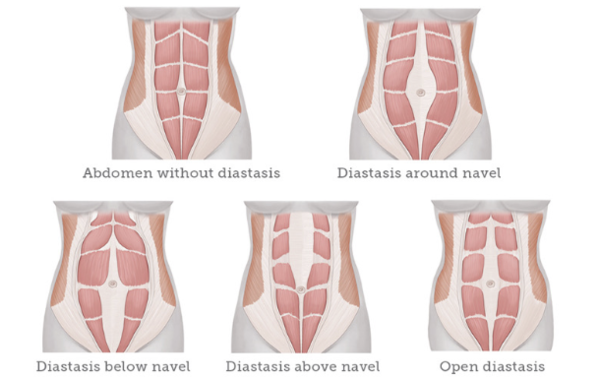
Aby Tobin
23 Nov 2021
What is Diastasis Recti?
Diastasis Recti is a separation of the Rectus Abdominis muscles and the widening of the vertical centreline of the abdominal wall. All pregnant women will develop a degree of abdominal separation (Diastasis Recti) during their pregnancy.
It is a normal physiological change that happens to the tummy wall which makes room for the growth of the baby.
The right and left side of the superficial abdominal muscles (rectus abdominis) are joined in the midline with a band of connective tissue (made of collagen and elastin) called the linea alba.
The diastasis is not a tear, a hole, a hernia, or a sign of inflammation, if your GP tells you this, though a hernia can often be present after birth, do push for more information or book into your nearest Mummy MOT Practitioner.
Prevalence of Diastasis Rectus Abdominis (DRA) following childbirth is 60% at 6 weeks, 45% at 6 months, and 33% at 12 months (Sperstad et al., 2016).
Diastasis Recti is a separation of the Rectus Abdominis muscles and the widening of the vertical centreline of the abdominal wall. All pregnant women will develop a degree of abdominal separation (Diastasis Recti) during their pregnancy.
It is a normal physiological change that happens to the tummy wall which makes room for the growth of the baby.
The right and left side of the superficial abdominal muscles (rectus abdominis) are joined in the midline with a band of connective tissue (made of collagen and elastin) called the linea alba.
The diastasis is not a tear, a hole, a hernia, or a sign of inflammation, if your GP tells you this, though a hernia can often be present after birth, do push for more information or book into your nearest Mummy MOT Practitioner.
Prevalence of Diastasis Rectus Abdominis (DRA) following childbirth is 60% at 6 weeks, 45% at 6 months, and 33% at 12 months (Sperstad et al., 2016).
The severity of postnatal diastasis ranges from width of two finger breadths (mild) to more than four / five finger breadths. Although the width is often measured it is the depth and laxity in the midline that is often more important functionally.
What are the Symptoms?
If you have a tummy gap you may have:
- A visible bulge or "pouch" that protrudes just above or below the belly button.
- Softness or jelly-like feeling around your belly button.
- Coning or doming when you contract your abdominal muscles.
- You may have difficulty lifting heavy objects, or performing some everyday tasks.
- Back pain.
- How can I check for myself if I have tummy separation?
- Your tummy gap will usually go back to normal by 8 to 12 weeks postpartum.
If you would like to check the size of your separation at home you can do the following:
- Lie on your back with your legs bent and your feet flat on the floor.
- Raise your shoulders off the floor slightly and look down at your tummy.
- Whilst using your fingertips, feel between the edge of your muscles. This is above and below the belly button.
- From there you can see how many fingers you can fit into the gap between the two muscles or other checks you can do to measure which is not the width of the gap – the depth and tension of your linea alba.
- Take a photo and email it to Mummy MOT if you are concerned, we can look at the photo and advise if you may have abdominal separation. Sometimes is not down to the width of the gap, but also your core, breath and pelvic floor strength.
How To Know If I Have Diastasis Recti?
If you think you may have abdominal separation we recommend making an appointment with a 'Postnatal Physiotherapist' such as The Mummy MOT for an official diagnosis. A Mummy MOT is a specialist postnatal examination for women following both vaginal and caesarean deliveries. It will assess how your posture, pelvic floor muscles and stomach muscles are recovering after birth. And if they’re not, then they can provide you with exercises and treatment to help in your recovery and to return to exercise safely.
Up to half of all women experience weakness in both the abdominal muscles and pelvic floor muscles after pregnancy and up to a third still have a tummy gap at eight weeks post-birth. This can cause instability or poor core strength leading to women developing pelvic or back pain or bladder, bowel and sexual dysfunction. These conditions should not be something you should just put up with as a result of having a baby.
It’s recommended that women have an initial assessment at 6-8 weeks postnatal, but they also treat women who gave birth years ago that may still have a tummy gap or related pelvic floor issues.
Up to half of all women experience weakness in both the abdominal muscles and pelvic floor muscles after pregnancy and up to a third still have a tummy gap at eight weeks post-birth. This can cause instability or poor core strength leading to women developing pelvic or back pain or bladder, bowel and sexual dysfunction. These conditions should not be something you should just put up with as a result of having a baby.
It’s recommended that women have an initial assessment at 6-8 weeks postnatal, but they also treat women who gave birth years ago that may still have a tummy gap or related pelvic floor issues.
You can also book a virtual assessment with me, Aby by clicking the following
LINK
Exercises To Help Heal Diastasis Recti
360 breathing
Mediation
Breathwork
and you can follow the Mother Fit Postpartum program being mindful of the recommendations by your practitioner.
Mediation
Breathwork
and you can follow the Mother Fit Postpartum program being mindful of the recommendations by your practitioner.

Aby Tobin
Share this article

